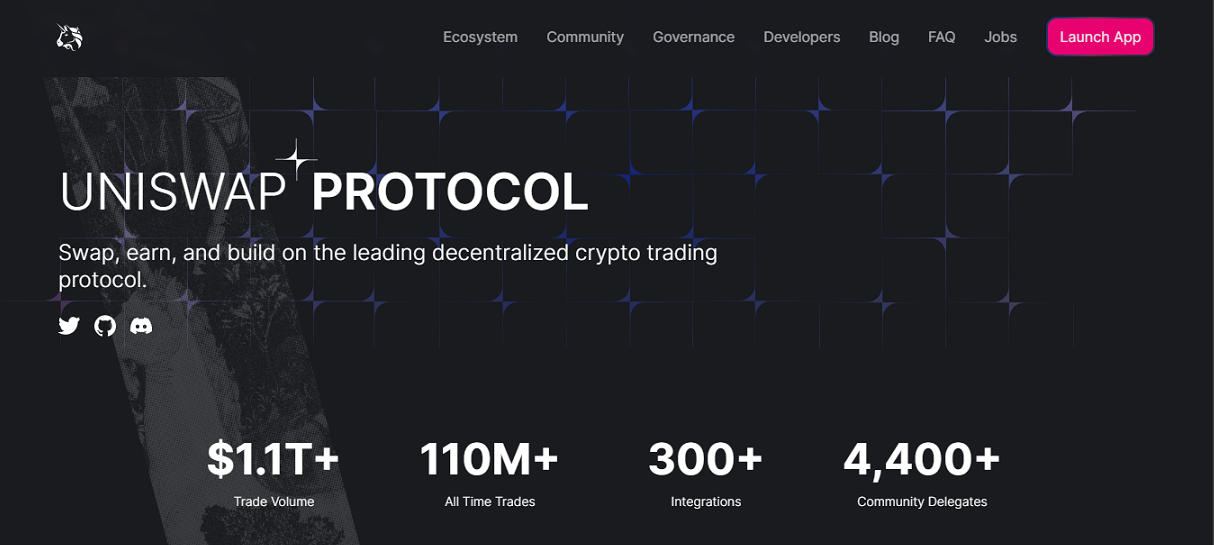UniSwap, a decentralized cryptocurrency exchange, is one the largest of its kind. You can swap cryptocurrency tokens easily through it, and you don’t even need to create an account. UniSwap’s liquidity pool allows you to earn interest on crypto holdings. It doesn’t allow you to buy or sell cryptocurrency. To learn more about the defining features of this product, what it offers and who it is for, read our complete review.
About UniSwap
UniSwap, an automated liquidity protocol, is one of the most widely used decentralized exchanges on the crypto market. The exchange is an Ethereum-based protocol that creates liquidity between ERC-20 tokens. It does this by using an autonomous liquidity system. This trading mechanism, which is relatively new, eliminates the need to have certified intermediaries and prioritizes security and scalability.
This platform is completely self-regulated and decentralized, so users have total control over their money. It’s not like a central exchange that requires users to give up their keys. It is therefore not possible for one business to manage or control the platform.
This exchange was the first permissionless DEX that allowed users to trade any Ethereum-based token directly without having to withdraw or deposit to a central order book. UniSwap eliminates the need for order books and uses an automated market maker to offer the best market rate. It employs a unique, deterministic algorithm. Uniswap offers the best market rate by allowing users to select an input token and output token.
It is now one of the most used exchanges on Ethereum. This allows people to trade cryptocurrency and swap assets. UniSwap is safer than traditional exchanges because it doesn’t hold any assets or have an order book.
Anybody can use UniSwap to trade ERC-20 tokens. Trading fees are earned by providing liquidity.
Top Recommended Platforms
78% of retail investor accounts lose money trading CFDs with this provider. You should consider whether you understand how CFDs work and whether you can afford to take the high risk of losing your money.
Trading forex or CFDs on margin involves a high degree of risk and may not be suitable for all investors. There is a possibility that you may suffer a loss equal to or greater than your entire investment.
CFDs are complex instruments and involve a high risk of losing money quickly because of the leverage effect. 68% of retail investor accounts lose money trading CFDs with this provider. You should consider whether you understand how CFDs work and whether you can afford to take the high risk of losing your money.
Who should use UniSwap?
This platform is a good choice for users who are looking for a platform with a variety of token options, pools and low transaction fees, even V3. This platform is a top choice for many reasons. The functionality is easy enough to use for anyone, even new users.
However, only Ethereum-based assets currently support the current version. Although it is possible to trade cryptocurrencies such as Bitcoin (wBTC), it is not currently possible to do so via UniSwap.
UniSwap Variations
UniSwap V1
UniSwap version 1 launched on Ethereum mainnet, November 2, 2018. UniSwap V1 only supported the swapping ETH-ERC-20 pairs. Users who wanted to swap USDC to DAI had to first swap USDC to ETH and then ETH to obtain DAI.
UniSwap V1 also enabled the creation of LP tokens. Liquidity provider tokens are given to liquidity providers who add liquidity to any pool. These LP tokens are then able to be staked or burned to redeem rewards. To reward LPs, trading fees are incurred.
UniSwap V2
The UniSwap V1 Proof-of-Concept was a huge success that encouraged the network to launch the UniSwap V2 in May 2020.
UniSwap V1’s biggest drawback was “ETH bridging”, i.e. the lack of ERC20/ERC20 token pool pools. This resulted in high spillage, and increased costs for users who wanted to swap ERC20 tokens.
Uniswap V2 was a major upgrade to the user interface and experience. It also eliminated the ETH bridging issue by allowing in the ERC20-ERC20 pool concept. UniSwap 2 and UniSwap 1 have significant differences. UniSwap 2 uses wrapped ETH rather than native ETH in core contracts, flash Swaps, and a native Price Oracle. Traders can still use ETH through helper agreements.
UniSwap V3
UniSwap’s latest UniSwap V3 was launched on May 20, 2021, via the L1 Ethereum mainnet. In March 2021, the original announcement stated that L1 optimism would follow soon.
UniSwap V3 offers a flexible fee structure that is more accurate and efficient than V1 or V2. Liquidity providers receive 400x greater capital efficiency than V2 and get higher returns on capital.
UniSwap V3 is designed to facilitate low-slippage trade execution and surpass both centralized exchanges as well as stablecoin-based automated markets makers.
UniSwap V3 Features
Concentrated liquidity: Liquidity providers can estimate the AMM’s shape, since they can create unique price curves that are based on their preferences. The capital of LPs can be centralized within specific price ranges to increase their liquidity at the desired prices. Concentrated liquidity reduces the capital that traders must invest. This feature allows for greater capital efficiency in the asset pool. The V3 pool contract cannot support standard ERC20 tokens. Instead, it requires that contracts be backed with additional logic to reinvest and distribute fees.
Active liquidity: When the market experiences price changes outside the LP’s price range, liquidity is taken automatically out of the pool. This means that it will not earn rewards. The liquidity is shifted to less-valuable assets while the market drives at the price range specified. This ensures that UniSwap traders are well-off. To earn rewards again, LPs may update their price ranges to reflect the current market price range.
Cryptocurrencies Available
UniSwap allows you to trade any ERC20 token. UniSwap can trade any ERC20 token that has been built on Ethereum.
This means that UniSwap can accept all types of cryptocurrency, big and small. Two of the most prominent are Ethereum and UniSwap, UniSwap’s native cryptocurrency.
UniSwap’s list has some significant gaps because many of the major cryptocurrencies are not built on Ethereum. Bitcoin (BTC) is the biggest omission, but there are other options. Wrapped Bitcoin (WBTC), an ERC20 token that is backed by Bitcoin, and designed to replicate its value, is the largest omission.
Alternatives
PancakeSwap
Gas fees for ETH transactions can be very expensive, especially when the network congestion is high. PancakeSwap may be an alternative for users looking to lower gas costs. It runs on the scalable Binance Smart Chain, which typically charges just pennies per transaction.
Coinbase
Coinbase is a popular central crypto exchange that offers a wide range of cryptocurrencies. You can transfer money from your bank account to purchase cryptocurrency. This exchange is easy to use for beginners, but also offers advanced tools for more advanced users.
1inch
UniSwap only supports ERC-20 coins. This can make UniSwap difficult for those who desire more. Oneinch is a good alternative, as it allows users to access tokens from multiple blockchains through one platform.
UniSwap Features
Liquidity Providers
UniSwap is able to offer crypto trading due to its liquidity providers, or LPs. LPs can earn crypto by providing liquidity. They also receive a cut from the exchange’s transaction fee. LPs can submit collateral to both sides of a market. This means that LPs are allowed to provide capital to any liquidity pool. To maintain Constant Product’s automated market maker, you will need to offer equal amounts of DAI and USDC.
UniSwap gives users liquidity tokens. These tokens track how much of a given liquidity pool you are responsible for when liquidity supplies are made. Tokens can be redeemed by liquidity providers at any time for the underlying collateral.
UniSwap charges 0.3% on every transaction. This fee is split between all liquidity providers to encourage them. These fees are immediately added to the market at transfer time. This results in greater spreads across the board. Pro-rata stakes give liquidity providers ownership of a greater pool capital. Simply put, the greater the number of transactions on the market, and the higher the fees collected, the greater the income that market makers earn.
Earning from Liquidity Mining
UniSwap is an AMM that uses crypto funds from its customers. These funds are kept in liquidity pools that each contain a pair of crypto currencies.
These pools allow anyone to deposit cryptocurrency and become a liquidity provider. This is known as liquidity mining. This is called liquidity mining.
Let’s take an example to illustrate how it works. Let’s suppose you have USD Coin (USDC), and Ethereum. Each crypto could be deposited to UniSwap’s USDC/ETH liquidity fund. You’d then earn crypto for every person who swaps USD Coin or Ethereum on the platform.
Liquidity Pools
UniSwap can be described as an automated liquidity protocol. Automated Market Marker is a smart contract that provides liquidity pools/reserves against which traders can trade. By depositing tokens to an Ethereum-based smart contract, liquidity providers can create a liquidity pool. A pool could include stablecoins like DAI, USDT and DAI. AMM traders are charged a fee that is divided among liquidity providers based on the percentage they stake in the pool.
Two types of smart contracts are used in UniSwap’s ecosystem: an exchange contract and a factory contract. The purpose of the exchange contract is to keep a pool of tokens. Users create new exchange contracts using the factory contract. These pools can contain pairs of tradable currency. An investor might place ETH and UNI in a UniSwap liquidity pool. They’d then receive a portion of the trading fees every time ETH is traded for UNI or UNI.
UniSwap liquidity pools have very little or no price impact due to the underlying mechanisms. This market maker model works by increasing the quantity of assets in the spot price. While large orders can have an increased price impact, the system never runs out of liquidity. UniSwap has an aggregate supply for smart contracts. This means that the probability of slippage in any trading pair will be lower the bigger the pool.
UniSwap makes it easy to set a maximum price for an order.
UniSwap Pros and Cons
| Pros | Cons |
| Swap ERC-20 tokens | Accepts fiat money only |
| You can earn crypto by liquidity mining | Risque of permanent loss |
| Support for crypto wallets | Only supports assets on Ethereum blockchain |
Fees
UniSwap charges an additional fee for each trade. Before UniSwap V3 introduced fees tiers based upon liquidity pool volatility, it was 0.3%.
- Very stable pairs – 0.01%
- Stable pairs – 0.05%
- Most pairs – 0.30%
- Exotic pairs – 1.00%
The flat fee of 0.3% per trade is slightly higher than the industry average of 0.25%. The exchange offers a decent service, however.
Low gas can lead to failed transactions. The exchange can become very busy. Even if you have enough ETH to cover the transaction fees, trades can fail. Your Ethereum will be reverted to your account if the transaction is unsuccessful. However, after deducting the gas fees, they cannot be refunded.
UniSwap withdrawal fees can be competitive with other exchanges that charge high trading fees, but have high withdrawal fees. Only transactions that have been completed are subject to network fees.
Verdict
UniSwap is able to provide traders with the DEX experience they have been looking for in a world that has many barriers and hurdles to entry. The largest DEX, as measured by multiple metrics, has been achieved with the help of developers who continue to improve and innovate.









